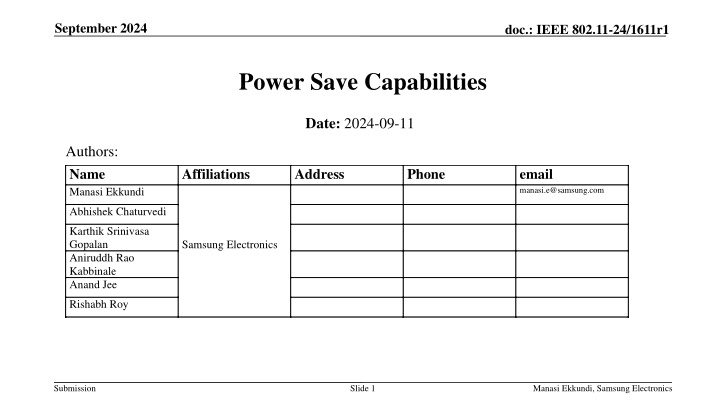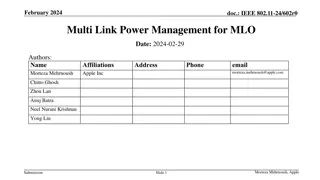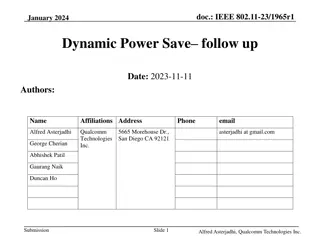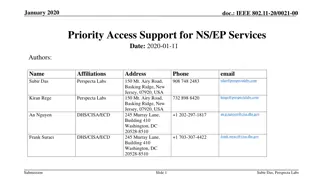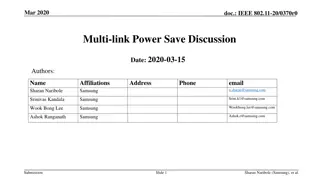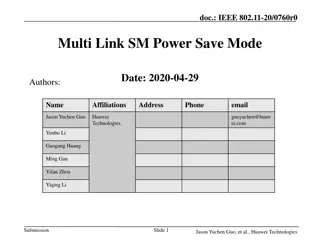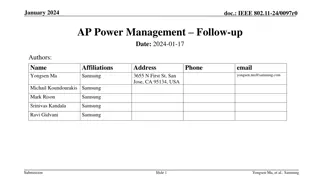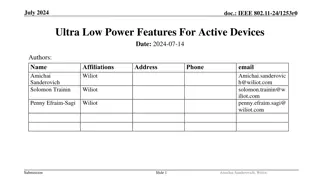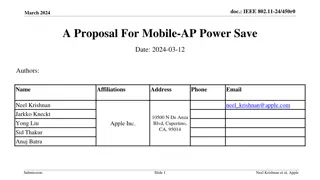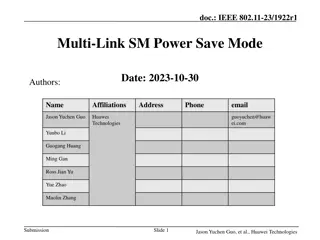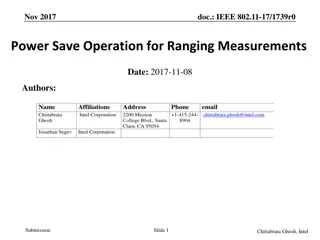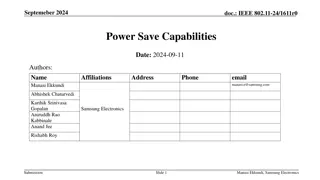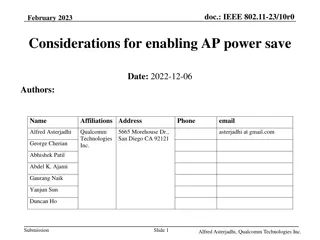IEEE 802.11-24 Power Save Capabilities
This document discusses the power save features standardized in IEEE 802.11 specifications, including APSD, PSMP, WNM, SMPS, and more. It highlights the need for a common framework for exchanging capability information, enhancing scalability and extensibility in future specifications. The problem statement addresses the non-extensible framework for power save capability exchange, emphasizing the importance of a unified approach.
Download Presentation

Please find below an Image/Link to download the presentation.
The content on the website is provided AS IS for your information and personal use only. It may not be sold, licensed, or shared on other websites without obtaining consent from the author.If you encounter any issues during the download, it is possible that the publisher has removed the file from their server.
You are allowed to download the files provided on this website for personal or commercial use, subject to the condition that they are used lawfully. All files are the property of their respective owners.
The content on the website is provided AS IS for your information and personal use only. It may not be sold, licensed, or shared on other websites without obtaining consent from the author.
E N D
Presentation Transcript
September 2024 doc.: IEEE 802.11-24/1611r1 Power Save Capabilities Date: 2024-09-11 Authors: Name Manasi Ekkundi Affiliations Samsung Electronics Address Phone email manasi.e@samsung.com Abhishek Chaturvedi Karthik Srinivasa Gopalan Aniruddh Rao Kabbinale Anand Jee Rishabh Roy Submission Slide 1 Manasi Ekkundi, Samsung Electronics
September 2024 doc.: IEEE 802.11-24/1611r1 Introduction IEEE 802.11 has discussed and standardized multiple power save features across various versions of the specifications like below: Automatic Power Save Delivery (APSD) Power Save Multi-Poll (PSMP) Wireless Network Management (WNM) sleep mode Spatial Multiplexing Power Save (SMPS) HE-Dynamic SM power save Restricted Target Wakeup Time (R-TWT) and so on Proposals in 802.11bn discuss more power save features for AP and STA: Dynamic Power Save : Defines that a STA that is a UHR Mobile AP or a UHR non-AP STA wherein the STA may transition from a lower capability mode to a higher capability mode upon reception of an initial control frame. [1] Scheduled AP Power Save: Defines AP Power Save mechanism through adjustment of the AP s schedule & capability in periodic intervals [2][3] Cross Link Power Save: Defines allowing a signalling mechanism to indicate the power management mode of other affiliated links on one enabled link [4]. Alternatively, for an AP an active state can be defined with one active link and the proposal allows the other links to transition from doze state to awake state or vice versa based on need or requests from non-AP STA. [5] There is an associated capability for each of these features (legacy or new power save feature) which needs to be exchanged between the AP and the non-AP STA. Slide 2 Submission Manasi Ekkundi, Samsung Electronics
September 2024 doc.: IEEE 802.11-24/1611r1 Problem Statement Non-Extensible Framework for Power save capability Exchange In current 802.11 specification, there is no common framework for exchanging capability information for power save features. Each new version of specification, introduced new power save feature(s) and their associated capability information element is distributed across various subfields. This design, hampers the extensibility of the framework. A typical AP usually needs to implement multiple power save features to support legacy devices. Extending this thought, even future specifications (802.11 bn and beyond) may introduce new power save features to handle the requirements of the day. But in the absence of an extensible framework, the design in the specification and associated implementation can become complex from scalability perspective. Hence there is a need to examine and introduce a common framework for such features. Submission Slide 3 Manasi Ekkundi, Samsung Electronics
September 2024 doc.: IEEE 802.11-24/1611r1 Problem Statement Power Save Feature Capabilities Mapping Automatic Power Save Delivery (APSD) Capability Information field Power Save Multi-Poll (PSMP) Extended Capabiltities field The table shows the capabilities information element which carries the associated power save feature. Depending on the feature, the information can carry whether the feature is supported and if there are any specific modes of operation within the feature that is supported and so on. Wireless Network Management (WNM )Sleep Mode Extended Capabiltities field Flexible Multicast Service (FMS) Extended Capabilities field Traffic Indication Map (TIM) Broadcast Extended Capabilities field Spatial Multiplexing-Power Save (SMPS) HT capabilities TXOP Power Save VHT capabilities HE-Dynamic SM Power Save HE Capabilities Restricted TWT support EHT capabilities Dynamic Power Save UHR capabilities? Scheduled AP Power save UHR capabilities? Cross link power save UHR capabilities? Beyond Tgbn power save feature(s) New version capabilities? Submission Slide 4 Manasi Ekkundi, Samsung Electronics
September 2024 doc.: IEEE 802.11-24/1611r1 Problem Statement Submission Slide 5 Manasi Ekkundi, Samsung Electronics
September 2024 doc.: IEEE 802.11-24/1611r1 Proposal A modular and extensible framework is introduced in capabilities. Power Save Feature Capabilities in Beacon, (Re)Association request/response, Probe request/response frames. Define frame format for power save capabilities Capability exchange framework for only power save capabilities Advantages : Forward compatible framework for Tgbn and future releases of 802.11 Design capabilities framework to be more modular and extensible or scalable. Submission Slide 6 Manasi Ekkundi, Samsung Electronics
September 2024 doc.: IEEE 802.11-24/1611r1 Power Save Feature Capabilities information field Order (Last assigned+1 ) Information Power Save Capabilities Notes The power save feature capabilities element is defined. Submission Slide 7 Manasi Ekkundi, Samsung Electronics
September 2024 doc.: IEEE 802.11-24/1611r1 Frame Format Sub-field 802.11 Version Definition This will define the version of 802.11 in which the power save feature is defined. Encoding 0- tgbn 1 tgbxxx* Extensible to future generations Length This indicates the length of the power save feature capability information This defines the power save feature that is part of this version of specification Power Save Feature n Each power save feature has its own frame format dependent on need. Example: 1 Dynamic Power Save 2 Scheduled Power Save 3 Cross link power save Submission Slide 8 Manasi Ekkundi, Samsung Electronics
September 2024 doc.: IEEE 802.11-24/1611r1 Power Save Capability Exchange Example use case STA AP2 AP1 STA AP With the new framework, STA can update if its capability is modified due to an issue that can occur at the STA like overheating or low battery events. Beacon Beacon Association Req Association Req Association Res M-AP Co-ordination Association Res In another use case, Multi-AP co ordination during power save events can be facilitated with the use of the new framework that allows for power save capability exchange between the APs. Capability update (PS capabilities) Overheating/ Low battery event Capability update (Power Save capabilities) Having a flexible and extensible framework is useful in this context as it can be used in various scenarios and also made future compatible to next versions of the specification. Normal temperature/ Battery recharged Capability update (Power Save capabilities) Case 1 Case 2 Submission Slide 9 Manasi Ekkundi, Samsung Electronics
September 2024 doc.: IEEE 802.11-24/1611r1 Conclusion New and improved power save features have been continuously introduced in various IEEE 802.11 version of the specifications. Each new feature is associated with a capability for which a new field/sub field is introduced within the information element of the capabilities associated with that version of the specification. This legacy design has created a non extensible non modular framework for capability exchange (in this case for power save capabilities) The proposal here discusses a more modular, extensible framework for exchanging power save features and capabilities for 802.11bn and future versions of the specifications. With such framework, it is possible to provide a capabilities exchange framework or tool which can be applied based on the requirements. Submission Slide 10 Manasi Ekkundi, Samsung Electronics
September 2024 doc.: IEEE 802.11-24/1611r1 Straw Poll 1 Do you agree to define in IEEE 802.11bn /TGbn a framework for including power save capabilities such that its associated power save features with their capabilities are exchanged between the AP and STA/AP? Submission Slide 11 Manasi Ekkundi, Samsung Electronics
September 2024 doc.: IEEE 802.11-24/1611r1 References [1] 11/23-1965r2 Dynamic Power Save follow up , George Cherian et. al. [2] 11/23- 1835r0 AP Power Management , Yongsen Ma et.al. [3] 11/24- 0097r0 AP Power Management Follow-up , Yongsen Ma et.al. [4] 11/23-2003r1 Client Power Save , Laurent Cariou et.al. [5] 11/24-352r Enabling Unscheduled AP PS Follow-up , Guogang Huang et.al. Submission Slide 12 Manasi Ekkundi, Samsung Electronics
